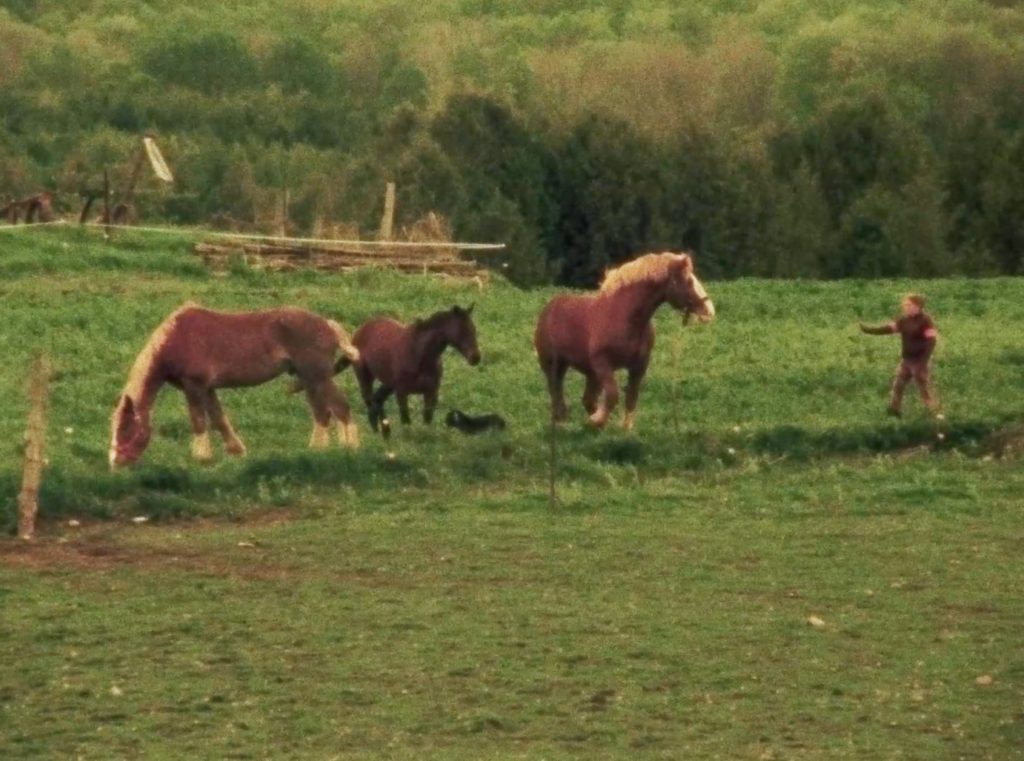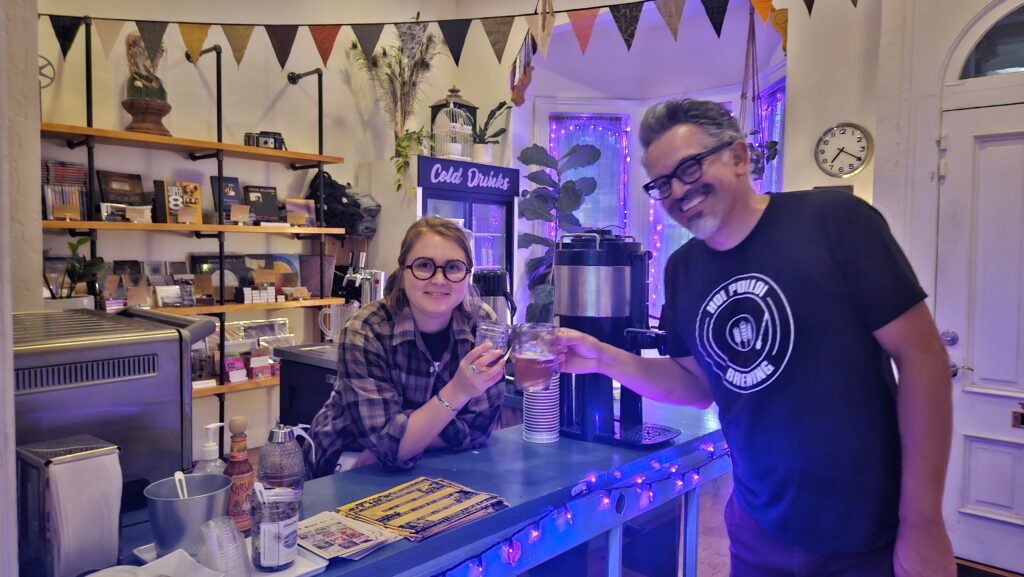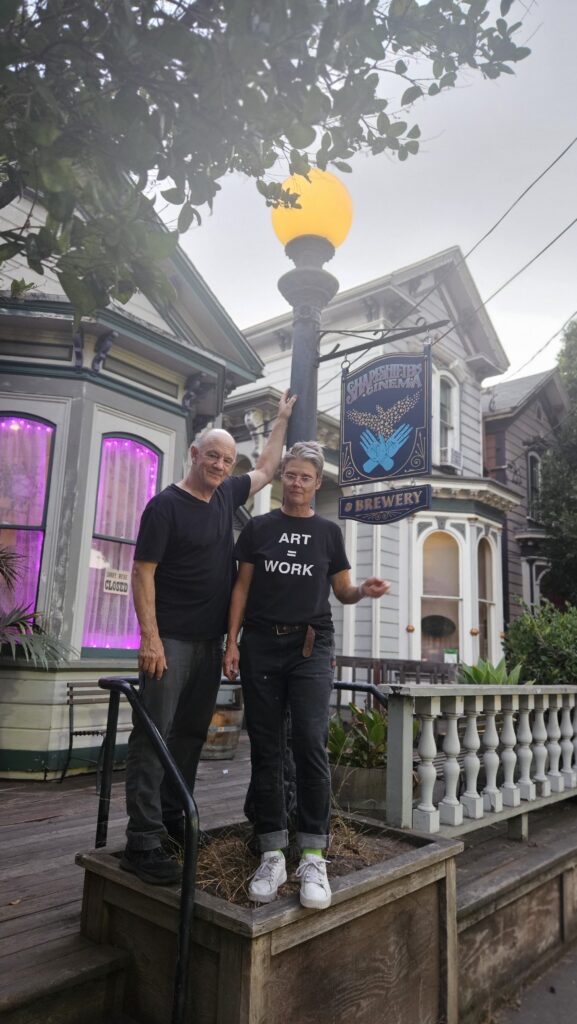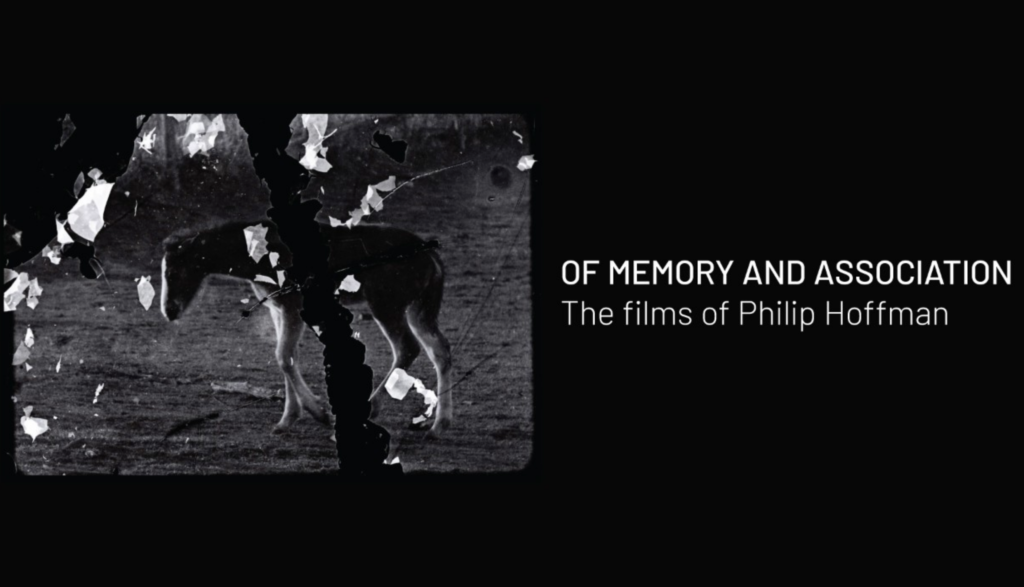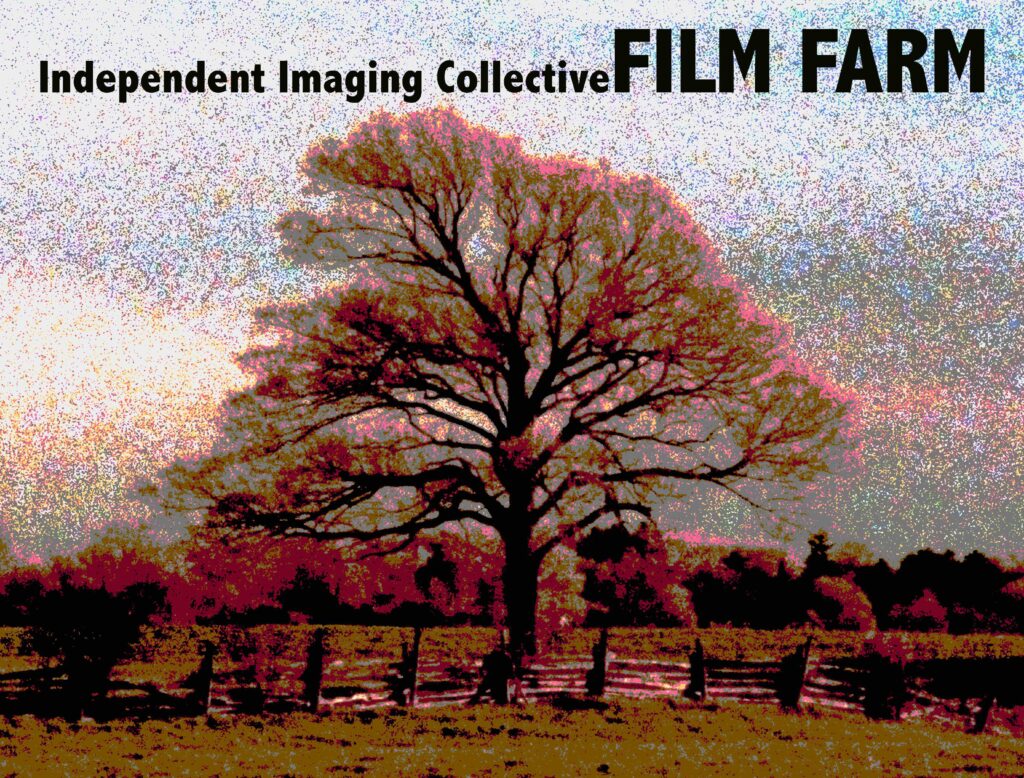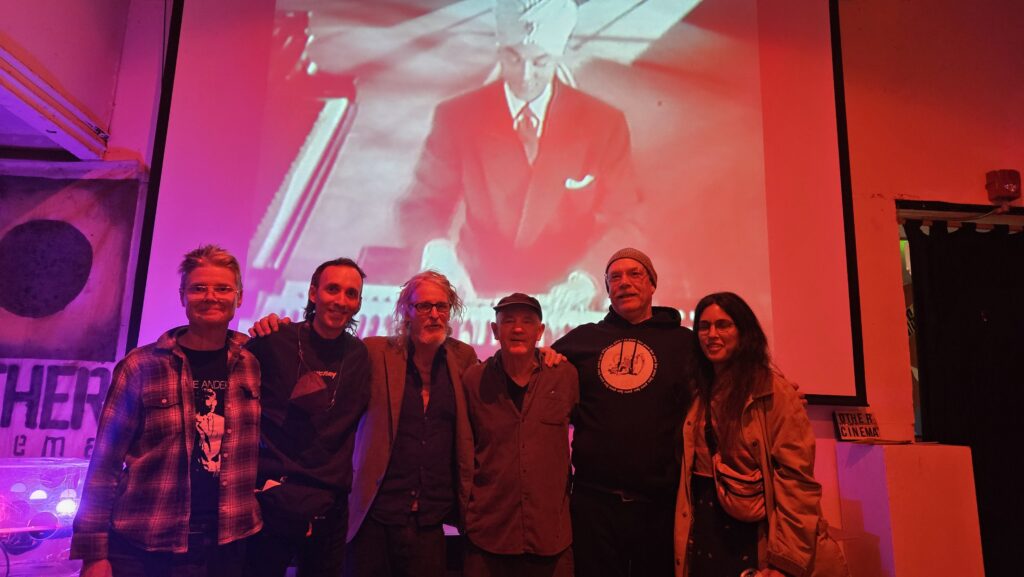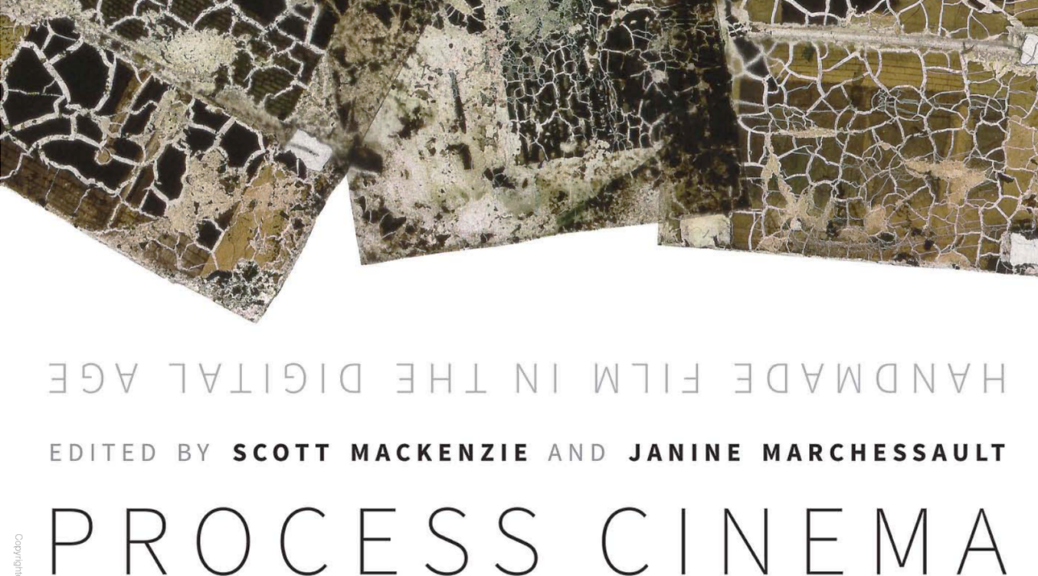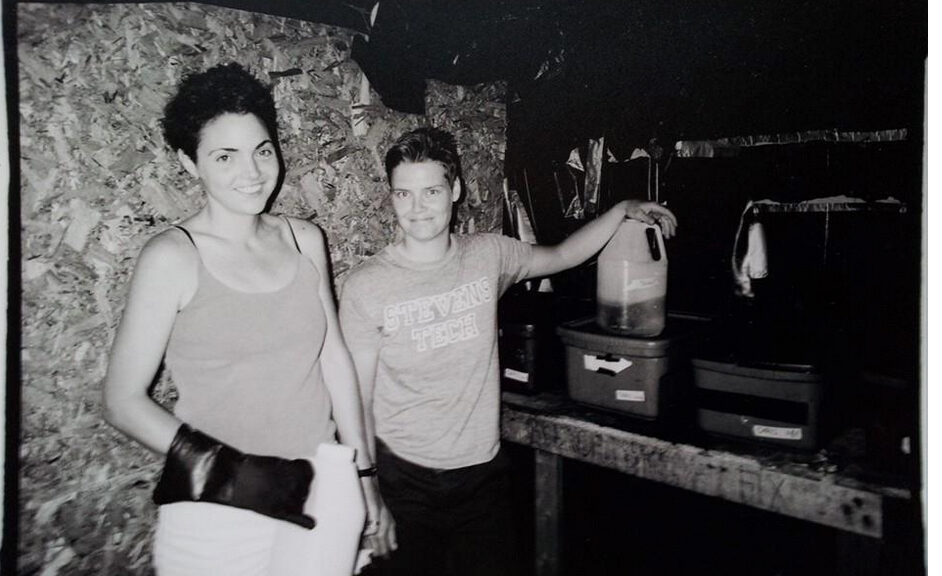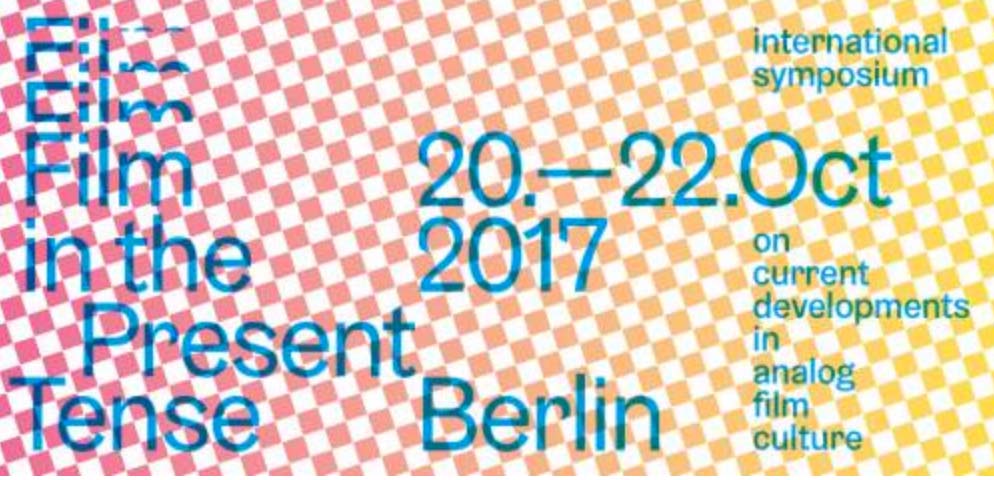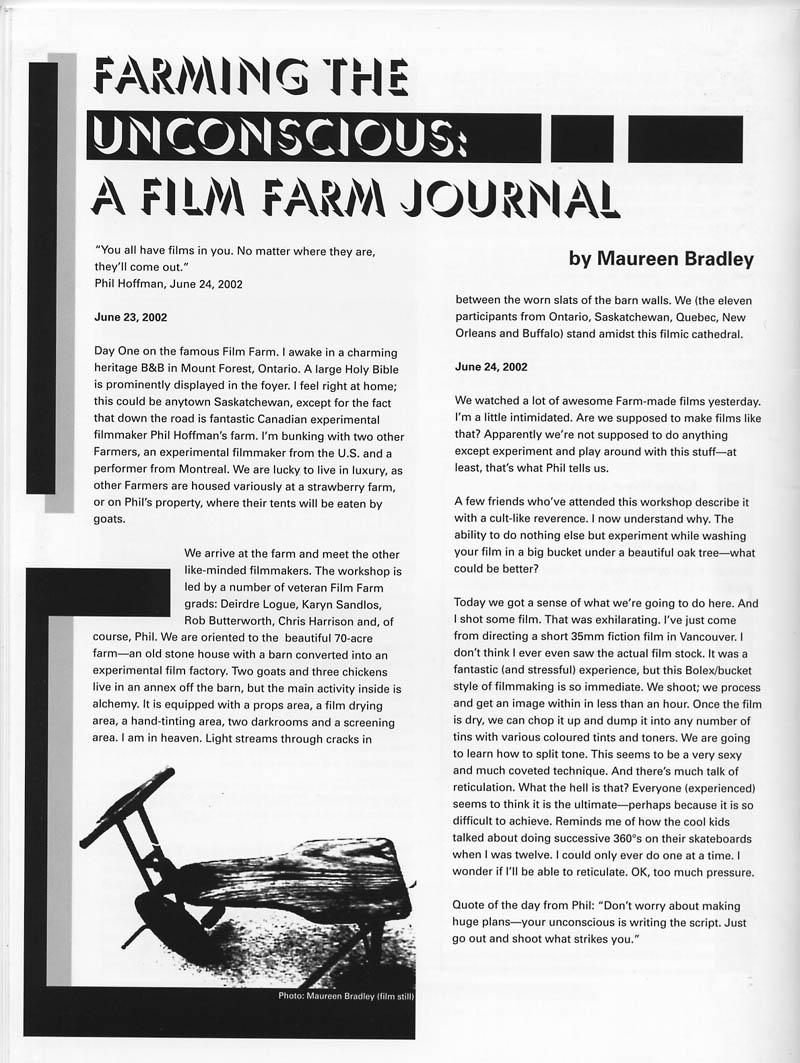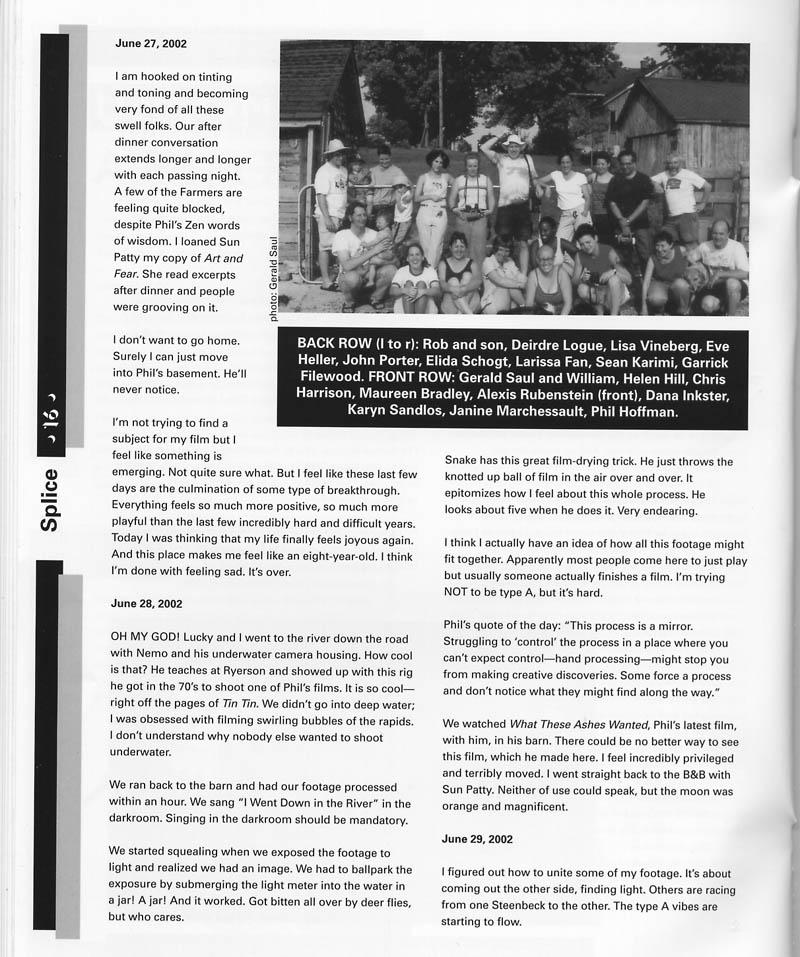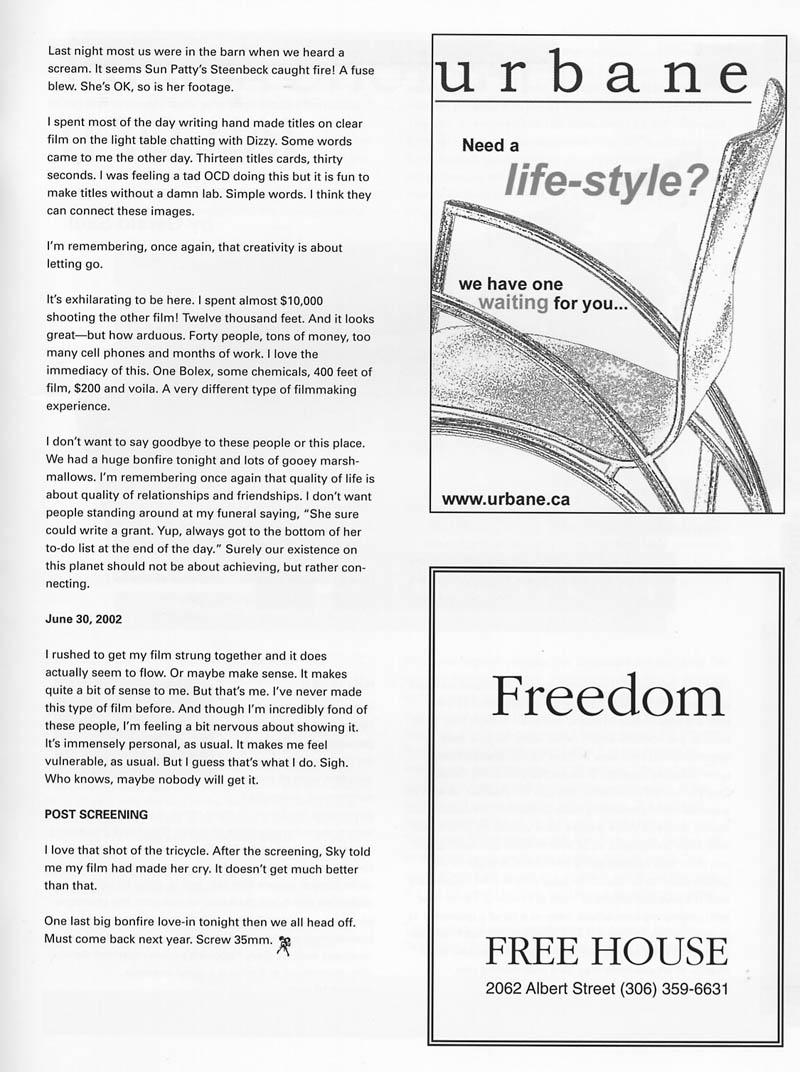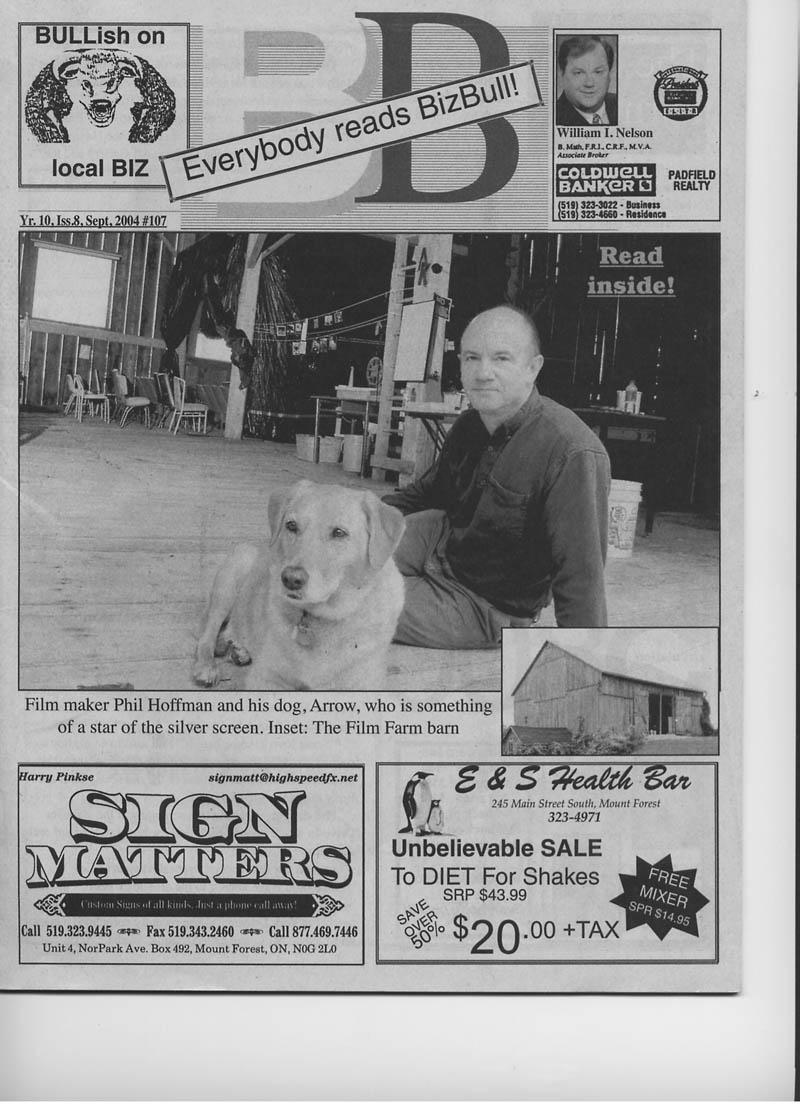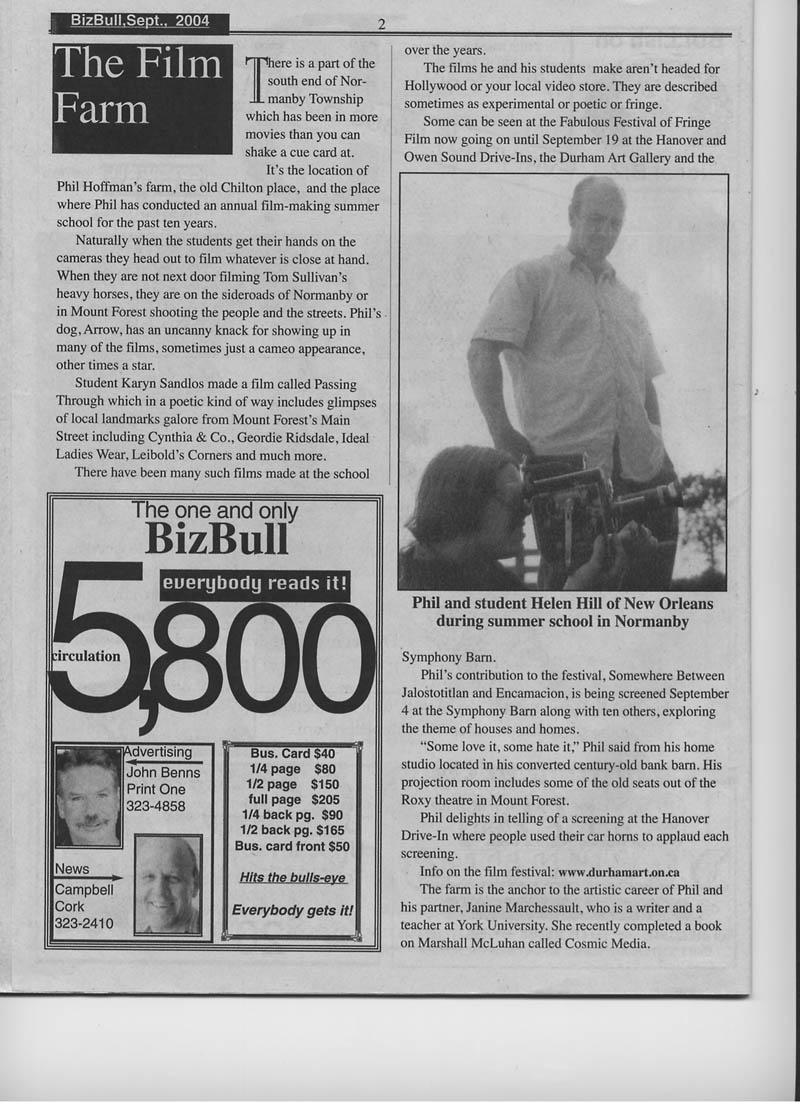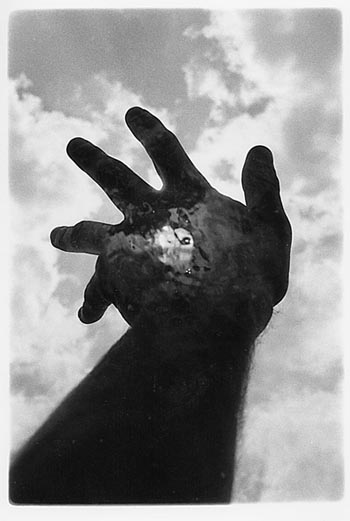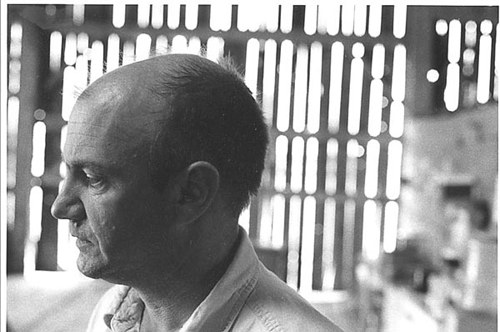*Karyn Sandlos & Deirdre Logue: `darkroom chores’ (photo by John Porter 2002)
by Janine Marchessault
The representation of nature has been a central and longstanding aesthetic preoccupation in Canadian art and iconography. Nowhere is this more in evidence than in a series of films that have emerged from Philip Hoffman’s Hand Processing Film workshop located on a forty acre farm in Southern Ontario. Since 1994, the films coming out of this summer retreat have been remarkable in terms of the consistency of their themes and innovative aesthetic approaches. One finds here a new generation of women experimental filmmakers exploring the boundaries between identity, film, chemistry and nature.
The creative context for these films is no doubt shaped by the experimental films and critical concerns of Hoffman and his late partner Marian McMahon. Since the late eighties, both Hoffman and McMahon were interested in autobiography, film (as) memory and pedagogy. Hoffman, weary of overseeing large classes and high end technologies at film school, conceived of a different pedagogical model for teaching film production. Instead of the urban, male dominated and technology heavy atmosphere, The Independent Imaging Workshop would be geared towards women and would feature hand-processing techniques in a low-tech nature setting.. The process encouraged filmmakers to explore the environment through film, and to explore film through different chemical processes. The result is a number of beautiful short films that are highly personal, deeply phenomenological and often surreal. Dandelions(Dawn Wilkinson, 1995), Swell (Carolynne Hew, 1998), Froglight (Sarah Abbott, 1997), Fall and Scratch (Deirdre Logue, 1998), Across (Cara Morton, 1997) and We are Going Home, (Jenn Reeves, 1998) are among the most striking, recalling some of Joyce Wieland’s most artisinal works and the psychic intensity of Maya Deren’s ‘trance’ films.
By artisinal I do not mean the aesthetic effect of ‘homemade’ movies produced by the uneven coloration of hand processing and tinting techniques. I am referring to the process of making films that is embedded in the final effect; that is, the work of film. Joyce Wieland’s work was often characterized as artisinal, a term that in the sixties and seventies was the opposite of great art. Famously, she made films on her kitchen table, bringing a history of women’s work to bear on her productions. In a video document of The Independent Imaging Workshop, three women sit at a kitchen table in a barn discussing the varying and unpredictable results of processing recipes: the thickness of the emulsion, the strength of the solutions, the degree of agitation, not to mention air temperature and humidity. Out of the lab and into the kitchen (or barn), film production moves into the realm of the artisan and the amateur which, as Roland Barthes once observed, is the realm of love. This is the home of the experimental in its originary meaning, of finding what is not being sought, of being open to living processes and to chance.
Like Wieland, this new generation of filmmakers is exploring the relationship between bodies, the materiality of film stocks and the artifacts of the world around them. The simple images of nature (daisies, fields, frogs, trees, rivers, clouds and so on) and rural architectures (bridges, barns, roads, etc.) are exquisite in their different cinematic manifestations. This is not idealized or essentialist nature, rather the landscapes are grounded in an experience of place. In Dawn Wilkinson’sDandelions for example, the filmmaker speaks of her relation to her birthplace and to home, “I am Canadian.” As the only black child growing up in a rural town in Ontario, she was frequently asked “where are you from?”. As she tells us about her experiences of being connected to nature while not being included in the history of a nation, we see her with dandelions in her hair; she films her various African keepsakes in the landscape; we follow her bare feet on a road and later, she does cartwheels across fields. The montage of images is delicately rhythmic, and is accompanied by a monologue directed at an imaginary audience “Where are YOU from?…I was born here.” Like so many of the films produced at the workshop, the film explores the relation between the natural landscape and social identity.
Several of the films display quite literally a desire to inscribe personal identity and history onto or, in the case of Carolynne Hew’s Swell, into the landscape. In Swell, Hew, lying on a pile of rocks, begins to place the stones over her body. The film is structured by a movement from the city into the country, but the simple opposition is undone by both the filmmaker’s body and film processes. The quick montage of black and white city images (Chinatown, bodies moving on the street, smoke, cars), accompanied on the soundtrack by a cement drill, is replaced by feet on rocks, strips of film blowing in the wind and beautifully tinted shots of yarrow blooms. There is no attempt here at a pristine nature, at representing a nature untouched by culture. Rather, the film is about the artist’s love of nature, her sensual desire to be in nature. Shots of her face over the city are replaced with images of nature over her body; yarrow casts detailed shadows on her thigh, a symphony of colors abound–orange, blue and fusia. Strands of film hang on a line and Hew plays them with her scissors as one would a musical instrument. The sounds of nature–crickets, bees, water–are strongly grounded in the sound of her own body, breathing and finally a heartbeat. There are no words in this film but everything is mediated through language and through the density of the filmmaker’s perception and imagination. The film is laid to rest on a beautiful rock as she scratches the emulsion with scissors, the relation between film and nature is dialectical. Nature here is both imagined (hand processed) and experienced. It is impossible to separate the two.
Deirdre Logue’s two short and deceptively simple films, Fall (1998) and Scratch (1998) also convey the filmmaker’s physical insertion into nature only this time the experience is not sensual release, rather it is a sadomasochistic and painful journey. In Fall, Logue falls (faints?) over and over again from different angles and in different natural locations to become one, in a humorous and bruised way, with the land. InScratch she is more explicit about the nature of her images as we read “My path is deliberately difficult”. Facing the camera, she puts thistles down her underpants, and pulls them out again. The sounds of breaking glass as well as the crackle of film splices are almost the only sounds heard in this mostly silent film. Intercut are found footage images from an instructional film, we see a bed being automatically made and unmade, glass breaking and plates smashed. This film is sharp and painful. Logue, beautifully butch in her appearance, is anything but ‘natural’; it is clear that the nature she is self-inflicting is the nature of sex. Her body is treated like a piece of emulsion–processed, manipulated, scratched, cut to fit. What is left ambiguous is whether the source of self-inflicted pain results from going against a socially prescribed nature or embracing a socially deviant one.
Sarah Abbott’s Froglight (1997) is even more ambiguous than either Swell or Scratch in terms of the nature of nature. The film opens with the artist’s voice over black leader, “I am walking down the road with my camera but I can’t see ,anything.” A tree comes into focus as she tells us “but I know I am walking ,straight towards something, we always are.” For Abbott there is ,something that exceeds the image, that exceeds her thinking about nature. She experiences a moment standing in a field, a moment that cannot be reduced to an image ,or words; ,she “experiences something that is not taught”, she does not want to ,doubt this experience because “life would be smaller.” Abbott touches the earth, we hear the sound of her footsteps, we see a road, we hear frogs, and later we come upon a frog at night. In the narration which is accompanied by the sound of frogs, Abbott attempts to put into words the idea of an experience that is beyond language, the idea that the world is much more than film, than the artist’s own imaginings. Like the soundtrack, the film’s black and white images are sparse. A magnifying glass over grass makes the grass less clear and is the film’s central phenomenological drive: surfaces reveal nothing of what lies beneath. Towards the end of the film, a long held shot of wild flowers blowing in the wind is accompanied by Abbott’s voice-over: “a woman gave me a sunflower before I came to make this film, and someone asked if it was my husband as I held it in my arm.” The ambiguity of this statement foregrounds the randomness of signs (flower, husband) and language. Froglight affirms a nature that is mysterious and unknowable, a world of spiritual depth and creative possibility.
What first struck me about so many of the films coming out of the workshop is the tension between the female self/body and nature; each film is in some way an exploration of the filmmaker’s relation to the land as place by cartwheeling, walking or falling on it, and in the last two films that I want to comment on, swimming and dreaming through it. Women’s bodies in Jenn Reeves We are Going Home and Cara Morton’s Across are not only placed in nature but in time. Temporality exists on two planes in all of the hand-processed films I have been discussing, not only in terms of the images of a nature that is always changing but also, in terms of film stocks and chemicals that continue to work on the film through time. Where workprints serve to protect the original negative from the processes of post-production, the films produced at the workshop use reversal stock and thus include the physical traces of processing and editing, an intense tactility that will comprise the final print of the film. This is what gives these films their temporal materiality and sensuality. In We are Going Home and Across this temporality is narrativized and it is perhaps fitting that both films experiment more extensively with advanced film techniques such as time-lapse cinematography, solarization, single-frame pixelation, split toning and tinting, superimpositions, optical printing and so on. Here is where these two filmmakers would part company with Wieland whose cinematic sensibility is, in the first instance, shaped by a non-narrative tradition. Both films are steeped in a narrativity that can be more easily situated in relation to the psychodramas of another founding mother of the avant-garde, Maya Deren.
In the films of Deren, nature and the search for self are always an erotic and deeply psychological enterprise. Dreams allow passage to a human nature and a mysterious self that cannot be accessed through conscious states. Her films have been characterized as ‘trance’ films for the way they foster this movement into the deepest recesses of the self, a movement that is less about social transgression as it was for the Surrealists, than about the journey through desire. We Are Going Home is a gorgeous surrealistic film that has all of the characteristics of the trance film and more. It is structured around a dream sequence that has no real beginning or end. The first image we see is of a vending machine dispensing ‘Live Bait’ in the form of a film canister.. A woman opens the canister to find fish roe (eggs). The equation of fish roe and film, no doubt a nod to the Surrealists, opens up those ontological quandaries around mediation and truth that Froglight refers us to. It is this promise of direct contact along with the return “Home” in the film’s title, that gives some sign that the highly processed landscapes belong to the unconscious.
The film is structured around a network of desire between three women. One woman dives into a lake and ends up feet first in the sand. Another woman happens by and sucks her toes erotically at which point everything turns upside-down and backwards. Characters move through natural spaces (the beach, fields, water) disconnected from the physical landscapes and from each other. Superimposed figures over the ground move like ghosts, affecting and affected by nothing. Storm clouds, trees in the wind, a thistle, cows are all processed and pixilated to look supernatural. Toe sucking complete, the second woman lies down under an apple tree and falls asleep, the wind gently blows her shirt open. A third woman, a dream figure, emerges from a barn; skipping through fields she happens upon the sleeping figure and cannot resist the exposed breast, she bends over and sucks the nipple. The film ends with a sunset and romantic accordion music that is eerily off key.
We Are Going Home is an erotic film whose sensuality derives both from the sublime image processing and from the disunity between all the elements in the film: the landscapes, the colors, the people. The sounds of birds cackling, water and wind that make up the soundtrack further intensify the film’s discordance. It is precisely this disunity that charges the sexual encounters which are themselves premised on an objectification. Home remains a mysterious place that exceeds logic and rationality; it is a puzzle whose pieces are connected in a seemingly linear manner but which will always remain mysterious.
In contrast, the psychic space in Morton’s Across is shaped through unity rather than disunity, the film is about crossing a bridge. The central tension in this lovely film, which accomplishes so much in a little over two minutes, is built upon a desire to connect with an image from the filmmaker’s past. The metaphoric journey forward to see the past is conveyed through a hand-held camera travelling at a great speed across a dirt road, through fields, along fences and through woods. Different color stocks combine with high contrast black and white images of the bridge while on the soundtrack we hear a river. As we travel with the filmmaker through these landscapes, we encounter a high angle solarized image of a woman sleeping in a field, a negative image of a woman swimming in the river below the bridge, a static shot of Morton staring into the camera, and home-movie images of Morton as a young girl running toward the camera. An intensity and anticipation is created in the movement and in the juxtaposition of the different elements. These are quietly resolved at the end of the film: the young girl smiles into the camera to mirror the close-up of Morton’s inquisitive gaze, the swimmer completes her stroke, stands up, brushes the water from her eyes and seems to take a deep breath.
The workshop films that I have written about reveal a renewal of avant-garde concerns and experimental techniques–they are unabashedly beautiful and filled with a frenetic immediacy. To some degree their aesthetic approach grows directly out of the workshop structure: location shooting and hand-processing. Participants (which now include equal numbers of men) are invited to shoot surrounding locations and to collect images randomly rather than to preconceive them through scripting. The aim of the workshop is not to leave with a finished product but rather to experiment with shooting immediate surroundings using a Bolex and with hand-processing techniques. Many of the films produced at the workshop are never completed as final works but stand as film experiments—the equivalent of a sketchbook. This is the workshop’s most important contribution to keeping film culture alive in Canada. The emphasis on process over product, on the artisinal over professional, on the small and the personal over the big and universal which has been so beneficial for a new generation of women filmmakers, also poses a resistance to an instrumental culture which bestows love, fame and fortune on the makers of big feature narratives.
Originally published in Lux: A Decade of Artists Film and Video, 2000

